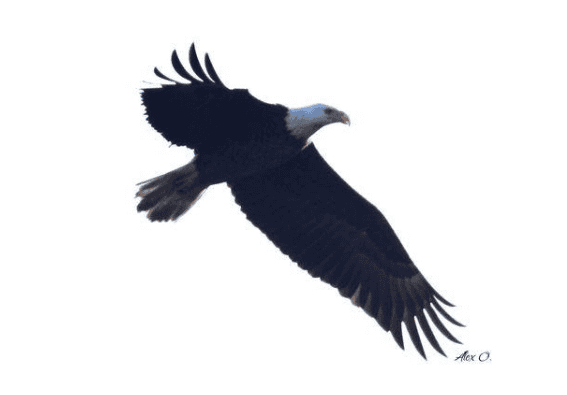A number of Bald Eaglets successfully fledged their nests across New Jersey, according to the New Jersey Bald Eagle Project 2021 report.
A 28-page New Jersey Bald Eagle Project 2021 report was published online in January through the New Jersey Department of Environmental Protection (NJDEP) Division of Fish and Wildlife’s Endangered and Nongame Species Program (ENSP) in partnership with the Conserve Wildlife Foundation (CWP).
Two hundred and forty-seven nest sites were monitored during the nesting season, of which 222 were documented to be active (with eggs) and 25 were territorial or housekeeping pairs, according to the report.
All known nest sites, which are in all 21 counties in the state, were monitored January through July, or through fledging. Volunteer observers from the ENSP and CWP watched most nests from a distance of 1,000 feet, using binoculars and spotting scopes, for periods of two or more hours each week, according to the report.
Dates were recorded for incubation, hatching, banding, fledging, and, if applicable, nest failure. A nesting territory is considered “occupied” if a pair of eagles is observed in association with the nest and there is some evidence of recent nest maintenance. Nests are considered “active” if a bird is observed in an incubating position or if eggs or young are detected in the nest, according to the report.
According to NJDEP’s Division of Fish and Wildlife, Bald Eagles usually mate for life, choosing the tops of large trees to build nests, which they typically use and enlarge each year. They require a good food base, perching areas, and nesting sites. Their habitat includes estuaries, large lakes, reservoirs, rivers, and some seacoasts. In winter, the birds congregate near open water in tall trees for spotting prey and night roosts for sheltering.
Pairs lay one to three eggs from mid-January to early March, and incubate for about 35
days. Upon hatching, the chicks are helpless and require close parental care.
After about five weeks, the young birds begin to stand up and feed themselves when the adults deliver food, according to the NJDEP.
Eaglets fledge the nest at 11-12 weeks in late June to early July. Adults continue to feed young near the nest for a month while the eaglets learn to fly and hunt.
In September many young eagles leave the area and may spend the winter in the Chesapeake Bay area, where open water and abundant food provide favorable conditions, according to the NJDEP.
The Bald Eagle, which has a lifespan of 15-20 years, is the national bird of the United States.
Adult Bald Eagles are distinguished by their full white heads and tails, but subadult and juvenile birds are brown overall with some white mottling. Both sexes have similar plumage, although the female is slightly larger than the male, according to the NJDEP.
With a wing span of six to seven feet, Bald Eagles are larger than most birds, but can be confused with vultures from a distance. While eagles eat mostly fish during the warmer months, they feed on waterfowl, muskrat and carrion during winter and early spring, according to the NJDEP.
Newspaper Media Group took a look at the nests located in its coverage area.
Burlington County
The nest at Crosswicks Creek in Bordentown saw the hatching of five eaglets, two of which successfully fledged the nest.
Mercer County
The nest at Mercer Oaks Golf Club in West Windsor saw the hatching of four eaglets, three of which successfully fledged the nest.
The nest in Princeton saw the hatching of three eaglets, one of which successfully fledged the nest.
The nest in Five Mile Run Park in Lawrence Township saw the hatching of three eaglets, one of which successfully fledged the nest.
Middlesex County
The nest at Cranbury Neck in Cranbury saw the hatching of three eaglets, one of which successfully fledged the nest.
The nest at the Edison Tower, Kin Buc Landfill Superfund site in Edison Township saw the hatching of four eaglets, two of which successfully fledged the nest.
The nest at Upper Millstone in Monroe Township saw the hatching of three eaglets, one of which successfully fledged the nest.
A nest in Old Bridge was marked territorial.
Monmouth County
The nest in Keansburg saw the hatching of four eaglets, one of which successfully fledged the nest.
The nest in Navesink B in Middletown saw the hatching of three eaglets, one of which successfully fledged the nest.
Ocean County
The nest at Prospertown Lake in Jackson saw the hatching of three eaglets, two of which successfully fledged the nest.
Somerset County
The nest at Duke/Raritan River in Hillsborough saw the hatching of two eaglets. Both eaglets successfully fledged the nest.
Bald Eagle habitat
Bald Eagle nests face many threats. Disturbance and habitat loss are the greatest threats in New Jersey, according to the report.
Disturbance is defined as any human activity that causes eagles to change their behavior, and takes many forms, including mere presence of people in nesting or foraging areas. In addition, contaminants in the food web may negatively affect the eagles nesting in some areas of New Jersey, according to the report.
ENSP biologists, with the Division’s Bureau of Law Enforcement staff and project volunteers, work year-round to protect Bald Eagle nest sites.
The competition for space in the most densely populated state in the nation makes it clear that critical habitat needs to be identified and, where possible, protected, to support a recovered Bald Eagle population. Critical habitat for eagles includes areas used for foraging, roosting and nesting, according to the report.
The federal government removed the Bald Eagle from its list of endangered species in August 2007, in recognition of the national resurgence in the eagle population in the lower 48 states.
The Bald Eagle’s official New Jersey status currently remains endangered for the breeding season and threatened for the non-breeding season, according to the report.

